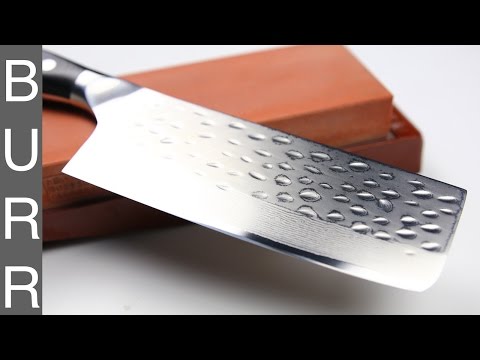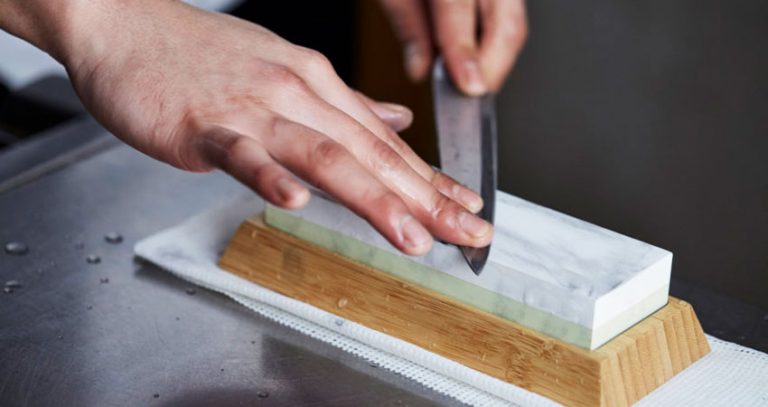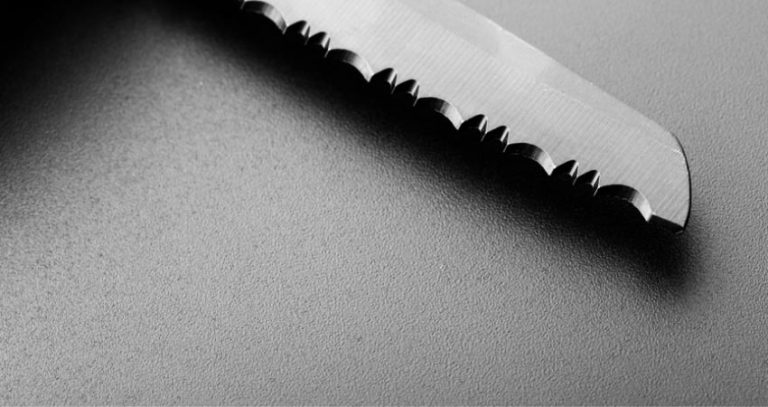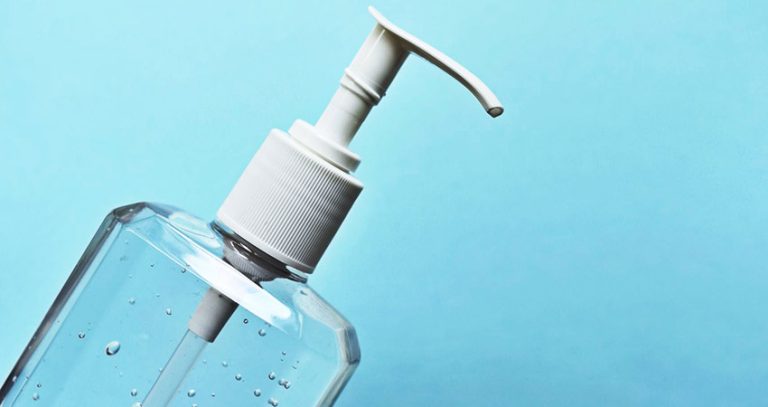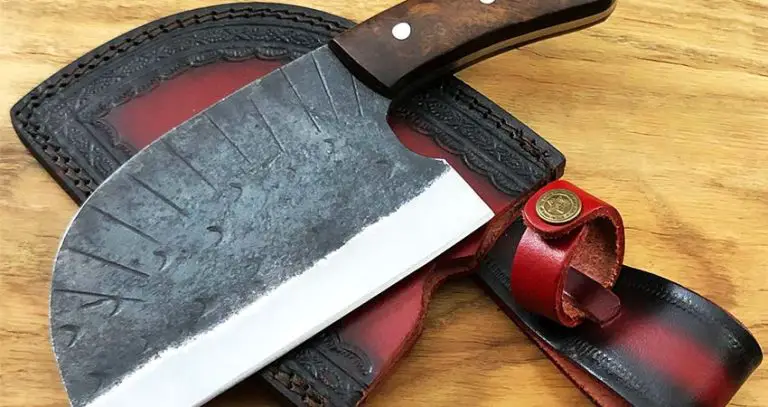How To Sharpen A Nakiri Knife?
Today we’ll be looking at how to sharpen a Nakiri knife. The Nakiri is a Japanese knife that has exploded in popularity in recent years.
Why? Because it does an excellent job of chopping vegetables.
When it comes to a Nakiri knife, sharpening is one of the most important skills you need to learn. After all, who wants a dull knife when chopping veggies?
In this guide, we’ll walk you through how to sharpen a Nakiri knife. We’ll teach you what tools and methods to use, as well as how to maintain your Nakiri.
What Angle Do You Sharpen A Nakiri Knife?
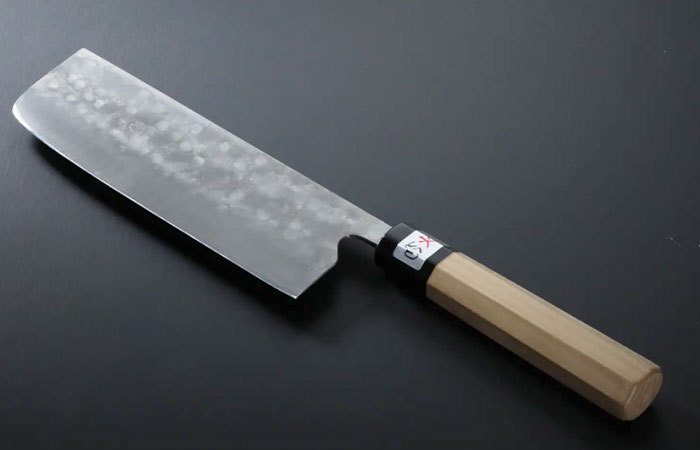
The Nakiri knife blade angle depends on the manufacturer and the type of steel used to make the blade.
Generally, both sides are sharpened at a 10 to 15-degree angle or up to 20 degrees in others.
So, manufacturers tend to use a different angle with their Nakiri knives. But it’s typically in the range of 10-20 degrees.
When in doubt, check with the manufacturer of your knife.
How To Sharpen A Nakiri Knife?
Sharpening a Nakiri knife is quick and easy. The process is much like sharpening a Santoku knife.
But since the Nakiri has a flat edge, you need to make sure to use a whetstone or honing steel. This will enable you to sharpen the whole blade.
How To Sharpen A Nakiri Knife Using A Whetstone
The best way to sharpen your Nakiri knife is by using a whetstone. Using this method, you can keep your knife in top shape for any culinary endeavor.
We recommend using a whetstone, preferably Japanese, but you can use other materials too.
Whetstones come in a variety of grits that range from coarse to extra-fine.
Coarse grit stones can tackle knives that have been severely damaged or have gone through the dishwasher on accident.
However, for most sharpening needs, we recommend using a medium grit stone. The extra-fine whetstone is for finishing touches.
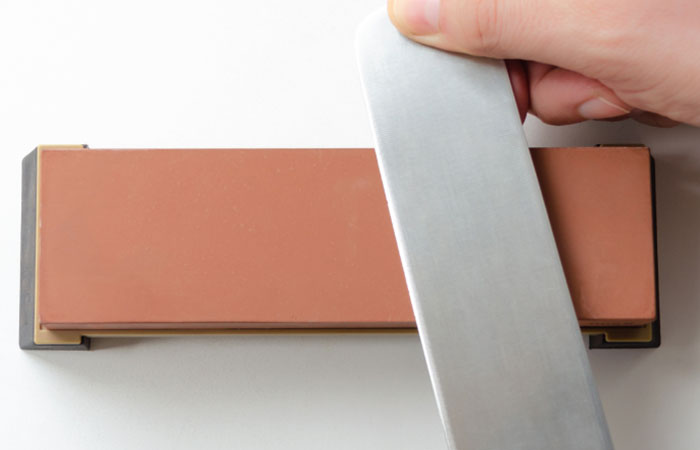
Step 1:
Find a whetstone that will allow you to sharpen your knife at the correct angle.
The best way is to check the manual for your knife and find out what angle it was sharpened at in the factory.
Step 2:
In order to sharpen a Nakiri knife, you’ll first need to prepare the stone.
Depending on your sharpening stone and whether or not it’s new, you may need to soak the stone in water for 30 minutes to an hour (or follow the manufacturer’s instructions).
Step 3:
Clean your knife so that it is free of debris, then place it on a cutting board such that the blade faces away from you.
Step 4:
Place the whetstone on a wet towel (so that it does not slip) and find the bevel angle of your knife.
Place your Nakiri knife at the correct angle against your whetstone.
Step 5:
Put firm pressure on the edge of your blade and push down along the length of the whetstone.
Stroke the blade, moving from heel to tip in one fluid motion.
Continue this motion on one side of the knife until you’ve sharpened the entire side of the blade.
Repeat on the other side – but this time moving from tip to heel.
Note: Be sure to pour water over the stone every few swipes. Check the edge of your blade periodically to make sure it’s getting sharper, but don’t check too often.
Step 6:
Once both sides have been sharpened, repeat step 5 with a finer grit stone until satisfied with how sharp your blade has become.
Step 7:
You can test whether or not your blade is sharp enough by slicing paper with no pressure applied.
When you have accomplished this task, your blade is ready to use!
How To Sharpen A Nakiri Knife Using Honing Steel
You can use a honing steel to sharpen your Nakiri knife. Honing steels are also referred to as “honing rods”, “sharpening steels” or even “knife steels.”
Honing steel helps realign the edge of the blade so it cuts more efficiently. They’re especially helpful when your knife is slightly misaligned after regular use.
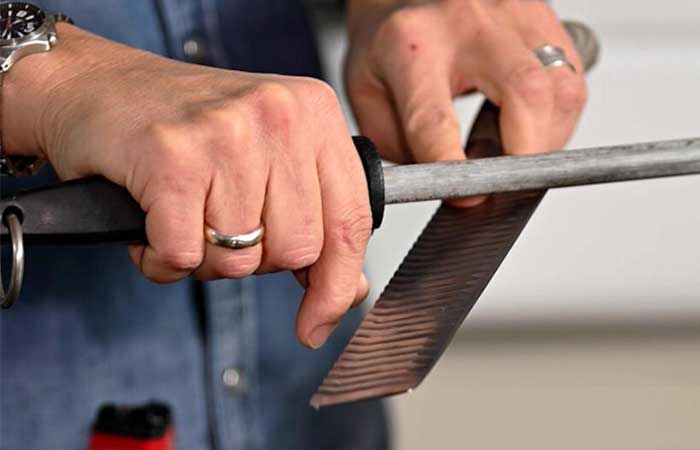
Step 1:
First, find yourself honing steel.
Honing steels come in several shapes and sizes, so do some research on the options and choose one that feels right for you.
Note: Always ensure that the honing steel is at least the length of the blade you’re sharpening.
Step 2:
Holding the handle of the steel firmly in one hand, push the point vertically on a cutting board or countertop.
Step 3:
Hold the blade of the Nakiri knife at the recommended angle against the steel.
Ensure its edge is facing you, as though you were about to cut something.
Step 4:
Stroke the blade by pulling it towards you down the length of the steel and then push it away from you up the other side of the steel.
Step 5:
Repeat this process 10 times on each side of the blade, or until you feel the knife is sharp enough.
Step 6:
Test your knife by slicing a piece of paper – it should cut through like butter!
Is My Knife 15 Or 20 Degrees?

Most Nakiri knives come pre-sharpened at a 15 or 20-degree angle. But if you don’t have a way to measure that angle, it’s tough to know for sure.
You can always ask the manufacturers if it is possible. You can also check the papers and manual that came with the knife.
But what is the DIY way?
Measuring knife angle with calipers and a calculator:
Step 1:
Measure blade thickness with calipers as close to the edge as possible.
However, if the blade is of uniform thickness, you can just measure the thickness of the spine – it’s the same thing.
Let’s say the spine thickness is 3mm.
Step 2:
Measure the slanted bevel height
Note: The bevel is the surface that’s ground to form the knife’s edge.
Let’s say you get 4 mm as the slanted bevel angle (just for illustration purposes).
For a double bevel Nakiri knife, this is what it will look like:
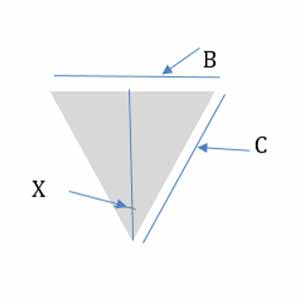
Where:
X = Edge angle
B = Spine thickness
C = Slanted bevel/edge height
Step 3:
To calculate the edge angle (X), we use the formula:
X = sin-1(B/2÷C)
So X = sin-1(3/2÷4)
Simplify, X = sin-1(1.5÷4)
So, X = sin-1 of 0.375
Use your calculator to find the sin inverse of 0.375, which is 22.02 degrees in this case.
So, the edge angle of our knife is 22 degrees (rounded off to the nearest degree).
Are Nakiri Knives Worth It?
If you need chopping performance for vegetables, Nakiri knives are worth their value. The thinner blade allows you to cut through veggies in one motion.
Nakiri Knife Use
Nakiri knives are great for chopping herbs, cabbage, squash, melons, or any other vegetables with hard skins.
It’s a handy knife for those who love chopping veggies into thin slices and want to do the job quickly.
Nakiri Knife Maintenance Tips
The Nakiri is a good knife for a lot of reasons.
But it does require a unique kind of maintenance so it will last you a long time.
- Use a plastic or wooden cutting board. Glass, steel, and marble will dull your knife quickly and may even chip the blade.
- When storing your Nakiri, don’t put it in a drawer with other knives – this can promote chipping. Always store your Nakiri knife on a magnetic rack or in a sheath.
- Make sure that you do not soak your Nakiri knife in water or detergent for long periods of time.
- Always hand-wash your knife. Never put your knife in the dishwasher as it will slowly corrode the blade over time.
- After cleaning, wipe excess moisture off your Nakiri knife with a soft cloth or paper towel.
- Sharpen and hone regularly using a whetstone or honing rod.
Conclusion
You’ve done it! You’ve learned how to sharpen your Nakiri knife. With these tips, you’ll have a sharp-as-can-be Nakiri knife in no time!
Now you can enjoy the benefits of cutting with a sharp, straight-edged blade that slides effortlessly through your ingredients.
We hope you have as much fun using your sharpened Nakiri knife as we did writing this article for you.


